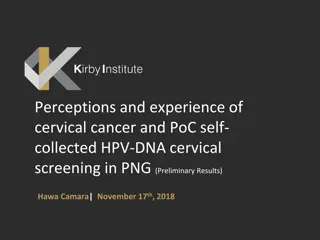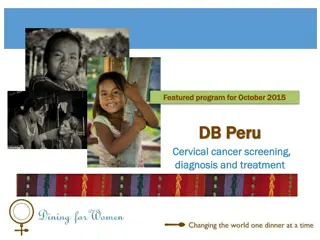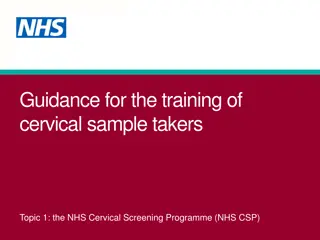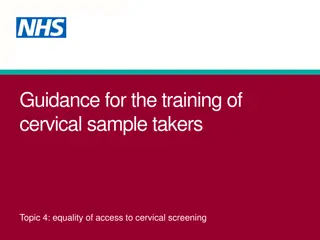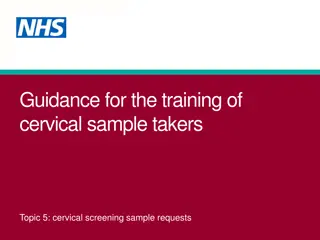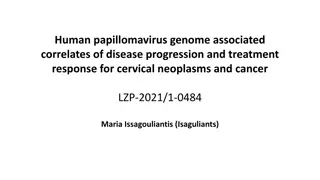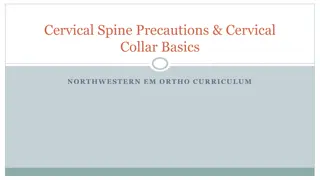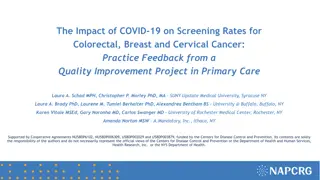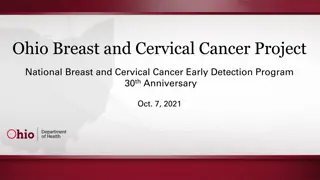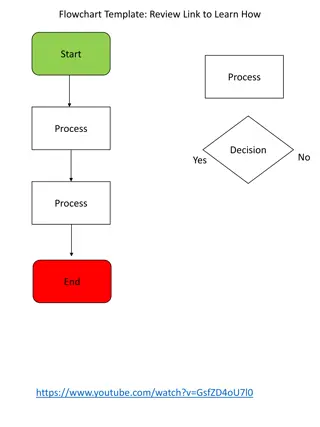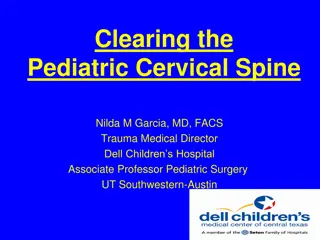Understanding Cervical Screening Test Results
Guidance provides information on understanding the results of cervical screening tests, including primary HPV screening and the significance of positive and negative test results. It also explains the reasons for repeating a sample and the management recommendations based on the test results.
Download Presentation

Please find below an Image/Link to download the presentation.
The content on the website is provided AS IS for your information and personal use only. It may not be sold, licensed, or shared on other websites without obtaining consent from the author. Download presentation by click this link. If you encounter any issues during the download, it is possible that the publisher has removed the file from their server.
E N D
Presentation Transcript
Guidance for the training of cervical sample takers Topic 6: understanding the test results
Note Use these slides in conjunction with the NHS Cervical Screening Programme publication Guidance for the training of cervical sample takers , available at: www.gov.uk/government/publications/cervical-screening-cervical-sample-taker- training 2 Topic 6: understanding the test results
Primary HPV screening (1) Primary HPV screening means that the high-risk human papillomavirus (hrHPV) test is the first test performed on the cervical screening sample. Cytology then becomes the triage test, performed only when the hrHPV test confirms hrHPV to be present. Most human papillomavirus (HPV) infections are transient and will eventually become inactive. Occasional HPV infections persist in an active state. The cervical screening laboratory tests for all of the important high risk types. An HPV positive result means there is active infection detected which may or may not be transient. An HPV negative sample means there is no active infection at the time of the test. 3 Topic 6: understanding the test results
HPV primary screening (2) hrHPV testing is performed on the sample taken for a cervical screening test. Where the test result indicates cytology triage, the cervical screening laboratory prepares a slide and examines it under the microscope for abnormal cells. The laboratory prepares the slide from the same sample, so there is no need for the person to return for a second test. The laboratory issues both test results as part of a single report. The management recommendation for a cytology result is included in the report. 4 Topic 6: understanding the test results
Test results The sample taker should understand: the possible test results the meaning of the results the reasons for repeating a sample 5 Topic 6: understanding the test results
hrHPVnegative The person returns to routine recall. There will be some exceptions to this and such cases will be evident in the report from the laboratory. The laboratory will not make a slide for cytology if the sample tests negative for HPV. There are no exceptions to this. 6 Topic 6: understanding the test results
hrHPVpositive People who test positive for hrHPV will have a cytology test performed. We refer people to colposcopy with abnormal cytology (borderline changes or worse). 7 Topic 6: understanding the test results
hrHPVpositive with cytology negative test result We classify adequate samples with no abnormal cells as negative. People who receive a negative cytology report will have a repeat sample in 12 months. If the HPV positive and cytology negative result persists, we refer the patient to colposcopy on the third occurrence of this result. If any repeat test is HPV negative, the laboratory will advise routine recall. 8 Topic 6: understanding the test results
Inadequate test result Occasionally an HPV test is unavailable, in which case the laboratory will advise a repeat sample in 3 months. Occasionally in a hrHPV positive sample, the cytology preparation will be inadequate. The laboratory will advise a repeat sample in 3 months. To allow for cell regeneration, the sample taker should not take a repeat sample less than 3 months after the previous test. A laboratory will report a sample as inadequate if the sample taker has not completely visualised the cervix, or if they took the sample in an inappropriate manner (for example with a sampling device not approved by the NHS CSP). We refer a person to colposcopy after 2 consecutive inadequate samples. 9 Topic 6: understanding the test results
hrHPVpositive with cytology abnormal We refer all abnormal cervical cytology to colposcopy (regardless of grade). 10 Topic 6: understanding the test results
Non-cervical abnormality (1) Cells from a non-cervical cancer may very rarely be present in the cervical sample due to shedding of cancer cells from the endometrium, fallopian tube or ovaries. A negative cervical sample does not exclude non-cervical cancer. The laboratory will report these as glandular neoplasia (non-cervical) , with a referral to gynaecology clinic recommended rather than colposcopy. The laboratory may not do a direct referral and will specify this in the report. In these circumstances, the GP must make an urgent referral through the cancer wait times (CWT) 2-week wait pathway. 11 Topic 6: understanding the test results
Non-cervical abnormality (2) Referrals to gynaecology clinics are not part of the cervical screening programme and are managed according to local protocols. The GP practice makes arrangements to inform the person of their diagnosis of non-cervical glandular neoplasia. The screening (negative) result letter advises the person that there is an abnormality and they need to make an appointment to see their GP as soon as possible. Sample takers should be aware of national protocols for the referral of people for colposcopy and guidelines for the clinical management of people. 12 Topic 6: understanding the test results
Post treatment protocol and follow-up After treatment for cervical intraepithelial neoplasia (CIN) or cervical glandular intraepithelial neoplasia (CGIN), people are invited back 6 months after treatment for a repeat cervical sample. The laboratory will test their sample for hrHPV, historically referred to as a test of cure (TOC). 13 Topic 6: understanding the test results
Test of cure post CIN We recall people for a screening test in 3 years (irrespective of age) if their HPV test is negative, and they can be returned to routine recall if the subsequent test result is cytology negative. We refer people who are HPV positive (regardless of cytology result) back to colposcopy. 14 Topic 6: understanding the test results
Test of cure post CGIN The laboratory carries out HPV testing 6 months post-treatment. If the HPV test is negative (provided there is confirmation of the CGIN being completely excised following treatment) we recall the individual for a further TOC in 12 months. If the second TOC is negative for HPV, the individual returns to 3 year recall. If that follow-up is negative for HPV, routine recall is appropriate. At any point in the TOC protocol, a positive HPV test results in referral back to colposcopy. 15 Topic 6: understanding the test results
Guidance for the training of cervical sample takers End of Topic 6. Understanding the test results 16 Topic 6: understanding the test results



